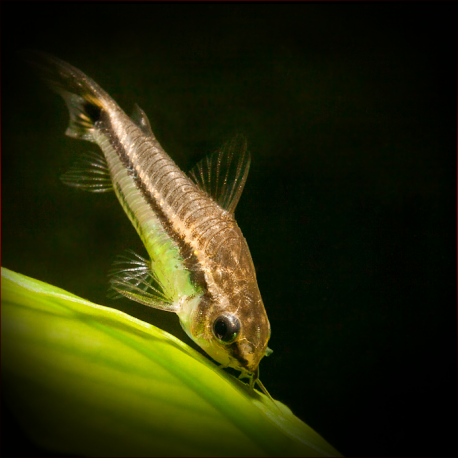More info
Datasheet
| Minimum Tank Size | 45 litres / 11.89 US gallons |
| Maximum Size | 3.0cm / 1.18inches |
| Temperature | 22°C / 71.60°F - 26°C / 78.80°F |
| Hardness | 2-15ºdH |
| pH | 6.4-7.4 |
General Description
Corydoras Pygmaeus, commonly known as Pygmy Cory, is a member of the Callichthyidae family and Corydoradinae subfamily. This species is part of the diverse Corydoras genus, which includes over 180 described species, renowned for their charming appearance and peaceful nature. With a maximum size of 3.0cm, the Pygmy Cory is a small, armored catfish with two rows of bony plates along its flanks, distinguishing it within the genus.
Aquarium Setup
The Pygmy Cory thrives in dimly lit environments and is ideal for heavily planted aquariums adorned with bogwood and twisted roots. A substrate of river sand, driftwood branches, and twisted roots can mimic an Amazonian biotope setup. This species benefits from surface vegetation to dim lighting, creating a natural and soothing habitat that resembles its native environment. Water parameters should ideally include a pH range of 6.4-7.4, hardness of 2-15 dH, and a temperature between 22-26°C.
Behaviour
This species of Corydoras is known for its peaceful demeanor but may not thrive in community settings due to its small size and timid nature. Pygmy Corys prefer being kept in groups of at least 6 individuals to exhibit their natural shoaling behavior. While they are compatible with other small fish species like characins and cyprinids, they are best kept away from larger tank mates and known predators. Additionally, Pygmy Corys tend to inhabit the middle levels of the tank, making them excellent dither species for dwarf cichlids.
Feeding and Diet
Pygmy Corys have small mouths and require food in tiny sizes. Their diet should consist of small-grade dried foods or ground pellets, supplemented with live or frozen foods like Daphnia or Artemia nauplii to promote optimal coloration and health. To prevent health issues, it is essential to offer sinking varieties of food to ensure they receive adequate nutrition.
Reproduction & Dimorphism
These Corydoras can be bred in captivity with careful attention to breeding tank setup, water parameters, and a varied diet to condition the fish for spawning. Sexual dimorphism is easily noticeable, with females being rounder and broader-bodied, especially when carrying eggs. During breeding, males fertilize eggs laid by females on tank glass, requiring diligent care for the vulnerable fry which need to be fed specialized food until they can consume microworms or Artemia nauplii.
Habitat and Distribution
Endemic to the Rio Madeira basin in Brazil, Pygmy Corys are commonly found in small tributaries, creeks, and pools within areas of flooded forests. In their natural habitat, they tend to seek shelter among marginal vegetation or tree roots, often congregating in significant numbers for safety and foraging purposes.

